
|
This page is graphic heavy, please be patient.

~Laisser moi vous dire comment jai commencer a devenir a
Cajun
dans mon coeur...~
~Let me begin to tell you how I became a Cajun at heart.~
~As you have read my deceased wife Jacqueline was from Belgium, we visited Belgium and France very often, I love the people, the
culture, the music, then one day in a casino in Reno I heard the
MUSIC, I followed my ears until I seen the tall man dressed in black playing the fiddle and singing and the little man with all
the French accordians sitting nearby playing, it was Doug
Kershaw...my feet could not stand still, I could not get
close enough. They called him "The Ragin Cajun", that he was and
more. After the Show I bought his casettes, he sat at our table
and spoke French with my wife, his band joined us, what
friendly people, they could have gone back to their rooms or gambled but they stayed with us and BOUGHT the drinks, we talked and talked and partied untill their next show started. We were to go home the next day but I reserved our room for two more days until his contract ran out, we became good friends but I have never seen him again except on TV and that is not very often in Washington State. That mon ami is when I became a Cajun at heart.
(Until I moved to S.W. Louisiana and seen him perform at the Isle Of Capri Hotel/Casino in Bossier City, La. in 2000, but was not allowed to get near him to visit again and have him meet my Cajun Queen.)
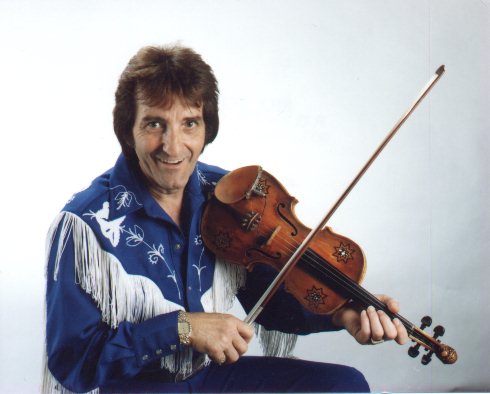
~In about December, 1998 I was helping a friend set up her
Webtv,
she was interested in Geneolgy when a search came upon
Cajun
music and a Doug Kershaw fan who also has a great interest
in
Geneolgy and carrying on the Cajun history, culture, music,
dance
and recipes for future generations.
| Lloyd Peterson
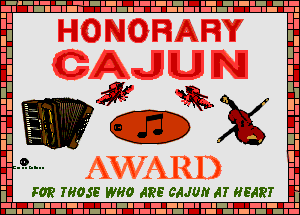
|
~Miss Grace, you have brought tears to this old mans eyes with
this
great Honor I hold dear to me. Le Bon Dieu vous
protege.~
~After I moved to Louisiana and married my internet friend Mary the local newspaper came over and interviewed us and took pictures for a page and a half artical about my life serving the public, the one of a kind birdhouse/feeders I build and my roses.~
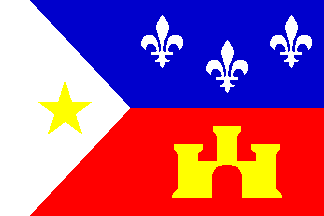
~ACADIAN FLAG~
~To commemorate the 200th anniversary (1965) of the Acadian
exile
into Louisiana and to remind us of other important
influences on
Acadians. Dean Thomas J. Arceneaux of USL, a native of
Carencro,
designed the Acadian Flag.~
~Exiled in 1755 from their native homeland, the Acadians
arrived
in Louisiana under Spanish rule. Because the Acadians
prospered
under Spanish rule, a portion of the flag bears the golden
arms
of Castile, a prosperous European Spanish kingdom, on a red
field.~
~The second third of the Acadian flag was designed to
symbolize
the French heritage. The three-petaled (silver on a blue
field)
fleurs de lis, (flowers of the Iris lily), was taken from
the
amorial emblem of the kings of France.~
~The last third of the Acadian flag, a white field
superimposed
by a golden star, has a dual meaning to the Acadians. When
the
first settlers departed France for the new world, the
Virgin Mary
was highly venerated; a period of great devotion to the
Virgin.
The King of France, Louis XIII, and the Pope, Pius XI, had
declared the Virgin Mary the patroness of the kingdom,
(Patronne
de Royaume), and Patroness Saint of all the Acadians in
Canada,
Louisiana and elsewhere. According to history, on the eve
of the
Assumption of the Virgin Mary, August 15, important family
groups
arrived in America. Therefore, the gold star and the white
field
have deep religious significance, and was designed to
reflect
back to Acadians earliest beginnings.~
~The gold star on the Acadian flag symbolizes early Acadian
patriotism in the new world. The exiled Acadians arrived in
Louisiana around the same time the American colonist were
struggling to gain their independence from the British
crown.
When the war began, the Spanish king sent word to Benardo
do
Galves, Governor-General of Louisiana, to help the new
colonist
"harass" the British by assembling a "motley band" of 600
Cajuns,
blacks, mulattoes, etc. Vividly remembering what the
British had
done during the expulsion, they succeeded in capturing Fort
Bute
at Manchac, Fort Baton Rouge, Fort Charlotte at Mobile and
Pensacola.~
~The golden star not only has religious connotations, but
reflects Cajun patriotism as well. Because the Cajuns were
citizens of Spain at the time of the American Revolution,
their
star could not appear on the first American flag. This star
on
the Acadians flag now serves as a reminder of the Cajun's
participation in the American Revolution and of Louisiana's
contribution to the beginning of a new nation.~
~SITUATING ACADIANA~
~Acadiana is a region in South Louisiana occupied by the
Cajun
French, who were exiles from Acadie (Nova Scotia, New
Brunswick)
after the British tookover. The story of the Cajuns was
made
famous by Longfellow in his poem Evangiline. This region
has a
strong sense of community and though the flag is probably
not
recognized by any government body it is extremely popular.
In
fact the flag is as popular as the state flag in
Lafayette.~
~CAJUN HISTORY~
~The French province of Acadia (today's Nova Scotia and
surrounding regions) was settled in the 1600s by French
colonists, but the area became a British possession soon
afterwards. In 1755, as war neared between France and
England,
the British authorities demanded that the Acadians renounce
their
Roman Catholic faith and swear allegiance to the Crown. The
Acadians refused and the mass exile that followed is well
known
to all who have read Henry Wadsworth Longfellow's
"Evangeline".~
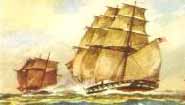
~The migration of the French Acadians to Louisiana was
neither
smooth nor immediate. Many were shipped to the New England
colonies, others to the West Indies or back to France, and
many
wandered for 20 years before learning that they were
welcome in
the predominantly French territory of Louisiana. Here they
established small farms along the Mississippi River, Bayou
Teche,
Bayou Lafourche and other streams in the southern part of
the
region. Fishing and trapping villages were established in
the
swamplands.~
~ Cajun (the word is a corruption of the original French
pronunciation of Acadian--A-ca-jan) Country today lies
within a
triangle whose base is the Louisiana coast and whose apex
is near
Alexandria in the central part of the state. The triangle
contains 22 parishes and the region's principal city,
Lafayette,
is the unofficial capital of "Acadiana".~
~Lafayette, the heart of Acadiana and the unofficial
capital of
Cajun Country, with its gleaming present belies an exciting
and
captivating past. Lafayette is a metropolis which displays
an
extraordinary mixture of tradition and progressiveness.
Having a
rich French heritage blended with Spanish, American, Indian
and
African influences, the city represents a colorful
combination of
lifestyles.~
~Lafayette lies 15 miles west of the Atchafalaya Basin and
35
miles north of the Gulf of Mexico and exhibits the
subtropical
climate typical of South Louisiana. The city is situated in
a
geographical area of forests and prairies interlaced with
bayous,
swamps and marshes.~
~The first known inhabitants, the Attakapas Indians, were
known
to have populated the Lafayette area in the 1700s. The
tribe was
very powerful and feared by other Indians. The Attakapas
dominated until three opposing tribes, the Opelousas,
Alabamons
and Choctaws, united in battle and conquered their
opponent.
Legend reports that the Attakapas Indians supposedly ate
their
prisoners of war.~
~The exact date when the first European settlers reached
the
Lafayette area is not known. Early historians report that a
few
trappers, traders and ranchers were present in the region
prior
to the Spanish occupation of 1766. A census conducted in
1769 by
Spanish Governor O'Reilly indicated a population of 409 for
the
area.~
~The historical event of the 18th century which had the
greatest
cultural impact on Lafayette was the migration of the
Acadians
from French Canada. Approximately 18,000 French-speaking
Catholic
inhabitants settled Acadie (now Nova Scotia) in 1605 and
lived
there under French rule until 1713 when the region went
into
English hands.~
~Faced with the refusal of the Acadians to pledge
allegiance to
the British crown and Anglican Church, English Governor
Charles
Lawrence took action. Acting on his own and not under
orders from
the crown as he professed, he gave the orders that led to
the
expulsion of the Acadians in 1755, also known as "Le Grand
Derangement."~
~Families were separated and as the Acadians went to sea
under
dreadful conditions, more than half lost their lives. The
exiles
ended up in many locations and in 1784, the King of Spain
consented to allow them to settle in South Louisiana. The
Acadians then joined a scattering of their people who had
arrived
as early as 1765 from the Caribbean and the East
Coast.~
~Some exiles settled at various locations along the Eastern
Seaboard of the United States, but most followed the path
which
led to New Orleans. There they received a hostile greeting
from
the French aristocracy so they headed west into unsettled
territory. They settled along the bayous of south central
and
south western Louisiana where they could live according to
their
own beliefs and customs.~
~The first settlement, known as Petit Manchac, was
established by
the English who used it during the Revolutionary War as an
outpost. It constituted a small trading post on the banks
of the
Vermilion River where the Old Spanish Trail crossed the
bayou
(about where today's Pinhook Bridge is located). The
village also
came to be known as Pin Hook, a name about which many
stories of
origin exist.~
~The years of 1765-1785 marked the great immigration period
of
the Acadians and many land grants were given by the French
and
Spanish governments. As a result of the Treaty of
Fountainebleau
in 1762, Louisiana went from French to Spanish rule. The
Spanish
actually took possession in 1766. The French Revolution of
1789
had its effect on Lafayette as many French Loyalists fled
to
Louisiana to settle. With the Louisiana Purchase of 1803,
Louisiana then became possession of the United States.~
~More specifically for Lafayette, in 1821, Jean Mouton (an
Acadian) donated land for the construction of a Catholic
church.
On May 15, 1822 Bishop Duborg created the church parish of
St.
John the Evangelist of Vermilion which encompassed the area
from
Mouton's plantation south to the Gulf of Mexico and west to
the
Sabine River.~
~A settlement grew around the church and on January 17,
1823, the
Louisiana Legislature created Lafayette Parish from the
western
portion of what was St. Martin Parish. Mouton made a second
land
donation to the new community, this time for a courthouse.
The
town of Vermilionville became the new parish's seat. The
settlement grew and the town of Vermilionville was renamed
Lafayette in 1844 in honor of the French Marquis de
Lafayette.~

~Time for a coffee break and a little humor, be right
back.~
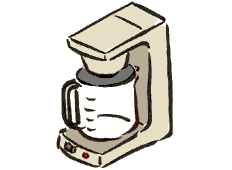

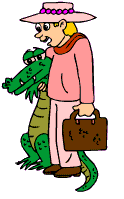
~"A Blonde And The Alligator Shoes"~
~A young blonde was on vacation in the depths of Louisiana.
She
wanted a pair of genuine alligator shoes in the worst way,
but
was very reluctant to pay the high prices the local vendors
were
asking. After becoming very frustrated with the "no haggle"
attitude of one of the shopkeepers, the blonde shouted,
"Maybe
I'll just go out and catch my own alligator so I can get a
pair
of shoes at a reasonable price!" The shopkeeper said, "By
all
means, be my guest. Maybe you'll luck out and catch
yourself a
big one!" Determined, the blonde turned and headed for the
swamps, set on catching herself an alligator.~
~Later in the day, the shopkeeper is driving home when he
spots
the young woman standing waist deep in the water, shotgun
in
hand. Just then, he sees a huge 9 foot alligator swimming
quickly
toward her. She takes aim, kills the creature and with a
great
deal of effort hauls it on to the swamp bank. Laying nearby
were
several more of the dead creatures. The shopkeeper watches
in
amazement. Just then the blonde flips the alligator on it's
back,
and frustrated, shouts out, "Damn it, this one isn't
wearing any
shoes either!"~
~On Parle Français en Louisiane~
~We Speak French in Louisiana~
~Exiled from their native homeland of Nova Scotia in 1755,
the
Acadians wandered aimlessly along the Atlantic seaboard for
years
before settling in the rich fertile soils of south
Louisiana. The
6,000 Acadians who refused to swear allegiance to the
British
crown were punished for their disloyalty with destruction
of
their homes and expulsion from their homeland.~
~This horrendous voyage marked 30 years of hardship and
humiliation for a proud group of people. At each location
of
disembarking along the Atlantic Coast, these refugees were
welcomed by open hostility. Through the generosity of the
Spanish
Government, Charles III, they were transported to south
Louisiana
where they settled on friendly land. Here, they established
small
farms along the swamp and prairie region of the Mississippi
River, Bayou Teche, Bayou Lafourche and other locations in
the
southern part of the state. For almost 200 years they
remained in
isolation because of inaccessibility to this region. Even
under
Spanish rule, a large majority of the colonists continued
to
speak French.~
~A distinct culture and a dialect known as "Cajun" French
was
born. Cajun French began in Nova Scotia between 1604 and
1756 and
traveled to Louisiana where it matured and further
developed. It
is the only modern North American language and has
undergone many
linguistic changes over the years.~
~There have been many speculations as to why Cajun French
has
survived and attained dominance for over 200 years. Many
conclude
that the geographic isolation of the Acadian settlements,
the
close-knit family structure and the lower socioeconomic
status of
the group has contributed to its endurance.~
~Several factors contributed to the changes and almost
extinction
of the language. In the 1930's, Governor Huey P. Long began
a
process to bridge the swamplands and lowlands with a
network of
roads bringing an end to the Acadians' isolated existence.
Another set back for the language occurred in the public
school
system when children were coerced by punishment to abandon
their
language and speak only English. Soon, this generation
became
ashamed of their language and were convinced of their
cultural
inferiority.~
~Through the efforts of the Council for the Development of
French
in Louisiana (CODOFIL), a reawakening of Cajun pride has
emerged.
CODOFIL has been responsible for protecting and promoting
the
French heritage of Louisiana through encouraging the
teaching of
French in elementary schools, student and teacher
exchanges, the
organization of national and international meetings,
festivals
and radio and television programs in French. Today through
CODOFIL's involvement, Cajun French is spoken proudly.~
~More than 260,000 Louisianans speak a form of French
either
brought to New Orleans by French nobility or to the bayous
and
prairies by Acadian immigrants. Research also shows that in
Louisiana, the older you are the more likely you are to
speak
French.~
~People who listed their home language as French, Cajun or
French
Creole make up two-thirds of the 391,994 Louisiana
residents who
told the Census Bureau in 1990 that they do not speak
English in
their homes. Louisiana residents make up the 13.6 percent
of the
1.9 million people who speak one of those three French
dialects
around the country. Those three groups account for 6
percent of
the 31.8 million people nationwide who speak a language
other
than English at home.~
~CULTURE, not blood, defines today's Cajun~
© Jim Bradshaw, Lafayette Daily Advertiser
~The 700,000 Acadians who live in South Louisiana make up
the
largest French-speaking minority in the United States. They
are
descendants of some of the first white men to settle North
America, coming from Brittany, Poitou, Normandy and across
France
to establish their first permanent colony in what is now
Nova
Scotia. That was in 1604, three years before Jamestown,
four
years before Quebec, and 15 years before the
Mayflower.~
~They were forced from their Canadian homes a century and a
half
later, and eventually settled in South Louisiana. Some
settled
along the Mississippi River above New Orleans. Others
migrated to
wetlands along Bayou Lafourche. Another group crossed the
Atchafalaya Basin to the country of the Attakapas and
Opelousas
Indians, near today's cities of St. Martinville and
Lafayette.~
~Each of these groups lived in relative isolation from the
Anglos, and to some extent, from each other, and developed
in
different ways. (There is, for example, no single "Cajun
French"
language, but distinguishable - to the trained ear -
regional
dialects, all based upon the original Acadian French, alike
in
sound and rhythm, but often with distinctive phrases and
modes of
expression. And you can start a battle royal among
different
Cajuns over just which instruments are proper to
"authentic"
Cajun music.)~
~The Cajuns were for several generations largely an
unschooled
and unlettered people, living simple lives, keeping to
themselves, their families and their lands. Because of
this, the
Cajun was often, and mistakenly, portrayed as a likeable
buffoon;
an ignorant, French-speaking, backwards swampbilly,
scraping a
bare existence from his surroundings; a pleasant,
easy-going
peasant who has nothing and wants less, as long as he can
go to
the fais-do-do (dance) on Saturday and to Mass on
Sunday.~
~Listen to Richard Ketchum, writing as late as 1974 in the
American Heritage Book of Great Historic Places: "(Cajuns)
speak
an ancient French dialect which few outsiders can follow .
. .
Mixing little with the modern world, they earn a living by
fishing, boating, trapping, and by selling handwoven
baskets and
cloth. In a region of few roads, they live on simple wooden
houseboats, dependent upon the waterways and the
pirogue"~
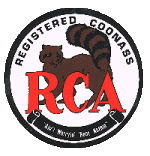
~In many places they were called "coonasses." Some of them
call
themselves that still. The bumper sticker, "Coonass and
Proud",
still bedecks many a pickup truck.~
~But times have changed, and so have the Cajuns. The
shantyboat
is no longer first choice for economical housing, and some
of
them live in real houses, on dry land, with paved sidewalks
leading right down to paved roadways. More Cajuns have
pickup
trucks than pirogues. Few Cajuns sell handwoven cloth or
homemade
baskets anymore (or know how to make either of them), but
lots of
them are still fishermen. Some trap still, gathering more
pelts
in the wild each year than all the rest of the United
States and
Canada combined. Some Cajuns are boatmen - Louisiana
operates the
largest fleet of working craft in the nation. (Duffy St.
Pierre,
a Cajun captain, gained instant fame - or notoriety - in
the
summer of 1987 by towing unwanted barge-loads of New York
garbage
around the Gulf of Mexico for a month.)~
~And lots of Cajuns are doctors, lawyers, architects,
accountants, even college professors. You'll find Cajuns
selling
shoes at Sears, running gasoline stations, driving taxis,
flying
airplanes, working at chemical plants, operating computers,
stringing telephone lines, raising crops and cattle,
delivering
the mail, running restaurants...doing the same thing that
people
do everywhere. Lots of them wear suits and ties. Some of
them,
the proud ones, still speak French from time to time -
sometimes
more often and more fluently than English. They feel sorry
for
folks who can speak only one language.~
~Some of them are beginning to object to being called
coonasses.
They say it's an ugly word that came into use after World
War II
by the combining of sound with the French noun conasse,
which
means a stupid person or prostitute. Others say it is more
innocuous, deriving from cunaso, a word coming from the
Caribbee
Indians, most likely via the Spanish, and meaning a fellow
who
lives simply, on and with the land.~
~And the standard Cajun caricature, as all of them are, is
too
broadly stroked to begin with. It was incorrect even in the
old
days. Acadians have played a healthy and wide-ranging role
in
Louisiana (And American) history. They fought the British
during
the American Revolution, and fought alongside Andy Jackson
at the
Battle of New Orleans. An Acadian presided over the
convention
that voted Louisiana out of the Union. Other Cajuns helped
the
state back in. There were two Acadian governors and another
served as lieutenant governor between 1840 and 1860. In
fact, an
Acadian, Alexandre Mouton, was Louisiana's first
popularly-elected governor. (Before him, governors were
chosen by
the legislature.)~
~Acadians built their vacheries (cattle ranches) on the
prairies,
held fine river plantations, founded towns that became
cities.
They sat in Congress and the legislature and on the bench.
(U.S.
Sen. John Breaux is a Cajun.)~
~But it's true, too, that Cajuns often did - and do -
things
their own way. The scholars tell us:
"Certainly no one will deny that . . . numerous . . .
Acadians
. . . resisted acculturation until well after World War II,
when
improved transportation and communication brought
mainstream
America into the darkest reaches of the swamp . . ."~
~More simply: The Cajuns thought it better to hold onto
traditional values, to maintain their own identity. It was
a
passive resistance, more often a shrug of the shoulders and
a
perplexed chacun a son goût (there's no accounting for
taste),
than an active fight. But they resisted, nonetheless, and
with
good reason.~
~It may not be as obvious now, but the Cajun has always
held a
healthy distrust of his English-speaking neighbors? Why
not?
These were the people who exiled him from his homeland, and
who,
later, used wealth and numbers to push him into the
hinterlands.
But he usually went peaceably enough. He just wanted to be
left
alone. He sought the isolation to maintain his culture. In
isolation, the culture sustained and reinforced itself,
developed
its own patterns.~
~But understand that the Cajuns aren't the only Frenchmen
in
Acadiana. There are a handful of French cultures here. The
Creoles of New Orleans descend from settlers who came to
Louisiana in the early 1700's. St. Martinville was called
Petit
Paris by aristocrats who fled there during the French
Revolution.
Refugees from Napoleon's army settled in Ville Platte and
elsewhere. French-speaking blacks from Haiti and other
Caribbean
islands were here early on. It causes some confusion when
we
start talking about who is a Cajun and who is not.~
~By strict definition, we could limit the term Cajun to
descendants of the Acadians exiled from Nova Scotia in
1755. In
fact, however, the earlier French and other settlers mixed
and
married with Cajuns and, more often than not, adopted their
ways
- so that today, some argue, you can find Cajuns who aren't
Acadian at all. (There's an old folk saying that you can
become a
Cajun in three ways : "by the blood, by the ring, or by the
back
door.")~
~You can make a good argument that it is the culture, not
the
blood, that defines today's "Cajuns."~
~That culture has certain obvious aspects: Not every modern
Cajun
speaks French, but his grandparents probably did. You'll
find
Protestant Broussards and Aucoins and Legers today, but
they
likely spring from Catholic roots. Even townfolks tend to
hold
some rural values and ways. The cuisine and the music hark
back to old traditions.~
 ~Cajun fathers teaching their children cajun dances to carry on cajun tradition~
~Latin blood shows through: Cajuns can be
quick
to anger, quick to laughter, and quick to change from one
to the
other. They play as hard as they work, but they work hard.
The
Cajun can still "make do" from the abundant resources
around him.
And he still wonders sometimes why anyone would want
more.~
~And there are subtler aspects: The Cajuns are a tolerant
people
- perhaps to a fault. They sometimes tolerate a little too
much
drinking, a little too much dancing, some chicanery in
their
politics. Some outsiders cluck their tongues and wonder
why. The
Cajun suggests that some things just aren't worth the
trouble to
change.~
~There are those who would argue that a Chinese reared in
Acadiana is more likely Cajun than an Acadian reared in
China;
that "Acadian" has to do with genealogy, but that the
culture
makes the "Cajun." Regional historian Revon Reed claims to
count
15 different kinds of Louisiana Cajuns, including Anglos,
Spaniards, even Yugoslavians and Filipinos.~
~He can start a good fight by arguing that in some of the
wrong
places. The back door to becoming a Cajun opens only so
wide. But
he's right about this: There's more to being a Cajun than
just
the blood.~
~My cyber-friend,VANCE
HUBBLE, said this to me, "Cajun at heart is the same as
being
a
cajun where I come from. Sa c'est mon ami me fait des
larmes a mes yeux.
Lloyd
~CAJUN CULTURE~
~Experiencing the Cajun culture is like no other. The
Acadians of
today are a thrifty, hard-working, fun-loving, devout
religious
folk. They work and play with equal enthusiasm.~
~The word Cajun began in 19th century Acadie (now Nova
Scotia)
when the Acadians began to arrive. The French of noble
ancestry
would say, "les Acadiens", while some referred to the
Acadians
as, "le 'Cadiens", dropping the "A". Later came the
Americans who
could not pronounce "Acadien" or "'Cadien", so the word,
"Cajun"
was born.~
~ACADIAN LADIES~
~Black of hair, fair of skin
are these lovely Acadians.
figure shapely, smile so bright,
and they dance away the night.~
~Beauty rare, as all have seen
these magnificent creatures from Acadie.
flirting lightly with the gentelmen,
dancing and whirling with lovely bends.~
~Hair is flying, long and free,
these laughing ladies from Acadie.
fresh of face, mild of manner,
yet they do have a little temper.~
~A man is blessed to marry a "Cajun" Queen,
(like I did) a beautiful lady from Acadie.
she is always interesting, ever mild,
but has been known to be a little wild.~
~These lovely ladies of Acadie,
included as one of them, is me.
dancing wildly into the night,
having fun until daylight.~
~Author Unknown~

~The Cajun's pleasure-loving nature expresses itself in the
community festivals, dancing and food that are integral
parts of
bayou life. Cajuns are known for their "joie de vivre" (joy
of
living), and to add excitement to their food they
experiment with
herbs, spices and ingredients to create some of the most
flavorful dishes that people throughout North America now
enjoy.~
~One of the traditional favorite Cajun pastimes is an old-
fashioned crawfish boil. When the sacred "mud bugs" or
"crawdads"
go into the pot a breath of excitement fills the air.
Before the
great feast of the boiled crawfish, potatoes, onions and
corn,
youngsters make a mad dash for the crawfish tub poking the
live
crawfish with sticks while other family members participate
in
crawfish races.~
~Boiling crawfish is not the only way to enjoy the
crustaceans.
When crawfish go into the pot a number of delicious dishes
result
because there are almost as many ways to cook crawfish as
there
are swamps, ponds and ditches in which to catch them.
Crawfish
are served up in gumbo, bisque, étouffée, jambalaya, pies
or
patties. When the Cajuns aren't eating crawfish, they enjoy
other
world famous cuisine of Louisiana such as oysters, shrimp,
boudin, pralines, gumbo and red beans and rice.~
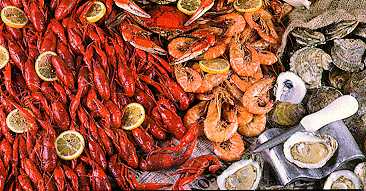
~What better way to experience Cajun food than at a
festival? Any
time is festival time. Towns and villages
throughout Acadiana celebrate every season with their
special
blend of music, food and the colorful Cajun heritage. Most
festivals feature live music of all sorts, contests, native
crafts and food and, of course, dancing.
~Cajun music is also distinctive. It can be lively or
melancholy,
and sometimes both at the same time. The main reason why
many
attend festivals is for the unique Cajun music. Cajun
music, once
deemed as "nothing but chank-a-chank" has infiltrated
radio,
television and classrooms and is becoming world famous for
its
unique sounds of instruments like accordions, fiddles and
triangles.~
~One of the largest festivals is our world-famous Mardi
Gras.
Celebrate an old-fashioned Mardi Gras at the Courir du
Mardi Gras

(Mardi Gras Run), one of the local traditions that makes
Mardi
Gras in Cajun Country truly unique. The spectacle
celebrated in
small towns and villages in Acadiana is a favorite of
visitors
interested in off-the-beaten-path experiences. With its
roots
firmly in the medieval tradition of ceremonial begging,
bands of
masked and costumed horseback and wagon riders led by the
unmasked "Le Captaine" roam the countryside begging for
ingredients for their community gumbo. The day's
festivities end
with a fais-do-do and, of course, lots of savory
gumbo.~
~YOU MIGHT BE FROM NEW ORLEANS IF:~
~You're out of town and you stop and ask someone where there is a
drive-thru daiquiri place, and they look at you like you have
three heads.~
~The four seasons in your year: crawfish, shrimp, crab and King
Cake.~
~You greet people with "Howzhyamomma'an'em?" and hear back "Dey
fine, darlin!".~
~Someone asks for an address by compass directions and you say
its uptown, downtown, backatown, riverside or lakeside.~
~Your burial plot is six feet over rather than six feet under.~
~You can pronounce Tchoupitoulas but can't spell it.~
~You don't worry when you see ships riding higher in the river
than the top of your house.~
~You consider a Bloody Mary a light breakfast.~
~The major topics of conversation when you go out to eat are
restaurant meals that you have had in the past and restaurant
meals that you plan to have in the future.~
~You judge a po-boy by the number of napkins used.~
~The waitress at your local sandwich shop tells you a fried
oyster po-boy dressed is healthier than a Caesar salad.~
~You know the definition of "dressed."~
~You can eat Popeye's, Haydel's and Zapp's for lunch and wash it
down with a Barq's and several Abitas, without losing it all on
your stoop.~
~The smell of a crawfish boil turns you on more than Chanel #5.~
~You wrench your hands in the zinc with an onion bar to get the
crawfish smell off.~
~You're not afraid when someone wants to ax you something.~
~You go by ya mom-en-ems on good Friday for family supper.~
~You don't learn until high school that Mardi Gras is not a
national holiday.~
~You push little old ladies out of the way to catch Mardi Gras
throws.~
 ~Throw Me Some Beads Mista~
~You leave a parade with footprints on your hands.~
~You believe that purple, green and gold look good together --
you will even eat things those colors.~
~You go to buy a new winter coat and throw your arms up in the
air to make sure it allows enough room to catch Mardi Gras
beads.~
~You have a parade ladder in your shed.~
~Your first sentence was "Throw me something mistah" and your
first drink was from a go-cup.~
~You wonder what Anne Rice has against a building that looks like
a Mardi Gras float.~
~You have a special set of grungy, well-broken-in-shoes you refer
to as your "French Quarter Shoes."~
~Every so often, you have waterfront property.~
~Your last name isn't pronounced the way it's spelled.~
~You know what a nutria is but you still pick it to represent
your baseball team.~
~You have spent a summer afternoon on the Lake Pontchartrain
seawall catching blue crabs.~
~You watch a movie filmed in New Orleans and say things like "Der
ain't no way they can run out of a cemetery right on to Bourbon
Street."~
~You describe a color as "K&B Purple."~
~You like your rice and politics dirty.~
~You worry about a deceased family member returning in spring
floods.~
~You reply to anything and everything about life here with "Only
in Nahlins."~
~You have a monogrammed go-cup.~
~A friend gets in trouble for roaches in his car and you wonder
if it was palmettos or those little ones that go after the French
Fries that fell under the seat.~

~You move somewhere else -- and you feel like you are from OZ and
you moved.~
~In Cajun Country, a week hardly goes by without chants of
praise
to crawfish, rice, alligators, cotton, boudin, yams, gumbo
and
andouille, all the necessities of bayou life. Within the
triangle
of Acadiana's 22 parishes, you'll experience the "joie de
vivre"
of the Cajun lifestyle. Whether in food, music or fun, the
Cajun
tradition continues to live on in the hearts of Cajuns and
visitors alike.~
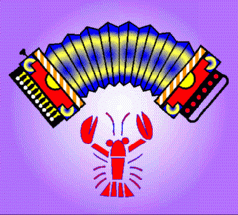
~CAJUN & ZYDECO MUSIC~
     
~Cajun music is the product of creolization, like most
other
features of Louisiana French culture. The Cajun sounds are
a
blend of German, Spanish, Scottish, Irish, Anglo-American,
Afro-Caribbean and American Indian influences with a base
of
western French and French Acadian folk tradition. They are
most
noted for their up-beat tempos, cheerful lyrics and
peculiar
dance rhythms. While there is no comparison to the sounds
of good
Cajun music, some say it reminds them of Bluegrass with a
French
accent, while others claim it is more like European folk
music.
Most Cajun music purists would agree that you must see as
well as
hear Cajun music performed to appreciate its richness. Most
people cannot keep from dancing to the Cajun waltz and
two-step
rhythms when they hear the hand-clapping, foot-stomping
sound in
its happiest, rapid-tempo forms.~
~The traditional Cajun instruments were the fiddle and
triangle. The Acadians who arrived in Louisiana possessed
no
instruments, but the knowledge of such came with them. They
soon
learned to make their own instruments from household items
like
spoons, washboards and clacking sticks for percussion. No
one
knows exactly where the tunes for Cajun music came from
because
the traditional music was not written. Each musician played
the
tune as he wished adding words here, deleting others
there.~
~The first Cajun record to hit the market was "Allons à
Lafayette" (Let's Go to Lafayette) in 1928. The record by
Joseph
Falcon of Rayne, became a regional hit. Afterwards, a
continual
stream of records by Cajun artists were released.~
~Music is an integral part of the Cajun way of life. This
is
evidenced by the many festivals held in the region with
entertainment provided by Cajun bands. While Cajun music at
one
time was confined to South Louisiana, today it has gained
recognition not only in the United States and Canada, but
also in
Europe. Cajun music has become so popular that the
President of
the United States was requested to issue a proclamation
calling
upon the people of the U.S. to observe the month of August
as
"Cajun Music Month."~
~Zydeco (pronounced Zah-dee-ko) is the most contemporary
expression of black Creole music. Zydeco, born out of a
music
called "lala", is a unique form of Black-Creole music
native to
Southwest Louisiana. The music is said to have originated
from
many sources, but the influence of the blues and soul music
is
most significant in its development. The word *Zydeco* has
also
been translated to mean "snap bean."~
~The Zydeco tradition of music was built by musicians with
little or no formal training who improvised the music of
their
generation out of the ones that came before them. Zydeco
music
was born in exile of ancient traditions which found
themselves
displaced in a New World where elder ways did not stand in
the
way of new combinations.~
~Zydeco bands are characterized fundamentally by the use of
the
"frottoir" (metal washboard) played with thimbles, spoons
or
bottle openers; and the use of the accordion and the
singing of
rhythm, blues and soul in Creole French.~
~It was not long ago that Zydeco was stereotyped as a music
for
rural folk. At present, there is an informal circuit of
devotees
to the Zydeco culture residing in New Orleans, Lake
Charles,
Houston, Port Arthur, Beaumont and Los Angeles who are
helping to
keep the Zydeco tradition alive. Zydeco musicians travel
monthly
to these cities to satisfy the appetite of these former
Acadiana
residents for the music, dance and spirit of the Zydeco
tradition. The fear of Zydeco music dying out prompted a
small
group of concerned citizens to organize different festivals
to
keep up the tradition.~
~There are several successful popular Cajun and Zydeco
bands
which reflect original, modern artistic and commercial
tastes:
Terrence Simien, Beausoleil, C.J. Chenier, Zachary Richard
and
Wayne Toups are potent draws in Lafayette and elsewhere,
and
their contributions are widely acknowledged if not always
rewarded. There are also many young, new bands keeping
Cajun and
Zydeco traditions alive as well as perpetuating their
evolution.~
~Cajun Music is bound by an ancient spirit. Somewhere
between
interlocked fiddle lines and accordion embellishments, in
the
spaces of silence between the notes, between the ringing
tone of
the 'tit fer, the triangle, there is a soul space where
musicians
and listeners visit one another. This space, and the
dancers and
musical instruments that move around it, hold the emotional
legacy of the Cajun culture. Cajun music is the heart of
South
Louisiana.
Jolie Blonde
Allons Danser Colinda
Valse de Ville Platte
Big Mamou Waltz
Jambalaya
Cajun Fiddle
Le Danse Mardi Gras
Ville Platte Waltz
Les Zydeco Sont Pas Sale'
J'a Passe Devant Te Porte
La Porte Den Arrier
Mamou Two Step
Allons a' Lafayette
Arc En Ciel
~Mary and I go to many Cajun,Zydeco and SwampPop dances and events where well known artist play and take pictures, here are some of them and wavs of thier music.~
Richard LeBouef
Louisiana Lullaby
Mel"Lovebug"Pellerin
Last Chance Waltz
Warren Storm
Wayne Toups
John Dale Hebert
ACCORDION
MANA True Honorary Cajun Friend
~BAYOUBEAT.COM RADIO SHOWS~
KBON-FM
~TRULY INSPIRED FROM GOD~
~This is the third e-mail I have recieved in a week about this
page, indicating I am carrying on the Cajun Traditions, this
page Truly Must Be Inspired From God.~
Thanks, Lloyd. I have your cajun music page saved. :-) And a
very good friend of mine who has been very sick and is in the
hospital also loves good cajun music. He will be thrilled when he
gets back home and on WebTV, and I show him your webpage, and
your cajun link.. I'm going to call him tonight at the hospital,
and I'll play the mamou 2-step for him over the phone. :-)
Thanks again.
~Ann~ (Kit)


Time for another Humor break:
~FLYING CAJUN AIRLINES~
~Pierre and Boudreaux was flying Cajun Airlines. Boudreaux
was
flying da plane and Pierre was in da back foolin wit da
cargo
equipment an stuff.~
~Da plane hit some turbulance an started bouncing aroun' an
Boudreaux got knock unconscience. Then da plane start
driftin.
Pierre him come run up to da front an Boudreaux was sprawl
out
over da steerin wheel.~
~Well, Pierre don know notin bout flyin an he start to get
panaky.He grab da microphone and holla
~"Dis is da control tower," someone answer. "Don you worry
about
nutin. We gona splain how fo you to land dis plane, step by
step,
ah gar-on-tee! Jus leave aryting ta us.~
~Fus, how high are you an what's you position?" Pierre
thought a
minute, den say, "I'm five foot ten an I'm all da way to da
front
of da plane."
"No! No!" answer da tower. "What's you altitude an
where's
you location?" Pierre say,
~"No! No! No!" came an exasperated voice. "Ah needs to know
how
many feet you got off da ground an how you plane's in
relation to
da airport!"~
~Pierre start to panic by dis time. He say, "Countin
Boudreaux's
an mine we got fo feet off da ground an I don bleve dis
plane's
related to you airport!"~
~A long pause --- "We needs to know who you next of kin
isand
where to send da flowers!"~:-)

~CAJUN RECIPES~
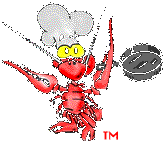  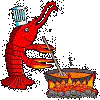
~The foods of the Acadians reflect a blend of traditional French
eating
patterns adapted to a foreign land and influenced by contact
with Micmac and Malecite peoples.~
~Most Acadians in the Maritimes are descendants of farmers
and labourers who came to the New World from central western
France in the mid-seventeenth century. They began a new life
in Acadie, where strong family ties and a common religion,
language and ancestral tradition helped to create an
independent, cohesive community.~
~The first group of Acadian settlers landed at La Have,
Nova Scotia, in 1632. In 1636, they moved tp Port Royal,
and as the population grew, they began to settle farther
up the Annapolis River and, by the end of the century,
along the Bay of Fundy. Eventually, a group settled on Prince
Edward Island. As a result of the Deportation (1755-1763),
these Acadians lost their land and were scattered around
the world.~
~Descendants of the Acadians who resettled in the
Maritimes after 1763 can be found today in pockets along parts
of the coastline of Nova Scotia, Prince Edward Island and
New Brunswick. Acadian cuisine has not changed much over the
centuries. Simplicity is STILL the main character.~
~In the early settlements, Roman Catholic religious
restrictions partly dictated food consumption. Acadians
abstained from meat for more than 150 days a year, and this,
in addition to the abundance of seafood in the Maritimes,
offers an explanation of fish, herring and cod
in particular.~
~Contact with native peoples also influenced the Acadian
diet. Corn, not used in Europe, became an ingredient for dishes
such as corn chowder and cornmeal cake. Acadians probably
learned hunting techniques from the Indians as well, bringing
rabbit, moose and game birds to their tables.~
~Pork was one of the principal meats, along with some beef,
mutton and chicken. The main vegetables included beans, corn,
peas, carrots and onions. The most popular were cabbage and
turnip, probably because these vegetables stored well over the
winter. The potato was not part of the Acadian diet in the
early period. Once it was introduced, however, it became a
mainstay.~
~The Acadian settlers, mostly farmers and fishermen, led a
less-sedentary existence that that of their descendants today,
and hard physical chores necessitated hearty meals. Breakfast,
for example, often consisted of foods such as blood pudding,
baked beans, head cheese or leftovers from the previous evening's
meal.~
~Grist mills supplied whole wheat, oats, buckwheat and barley.
Acadians traded flour made from grains for molasses and sugar
from the West Indies. Consequently, molasses became an important
ingredient.~
~Journals written by visitors to Acadie in the seventeenth
and eighteenth centuries refer to various drinks. French wine,
home-brewed apple cider, spruce beer and fir beer, rum from
the West Indies and milk accompanied meals. Milk was also left
to thicken and sour, to serve with bread. Historical documents
suggest as well that Acadians were the first to cultivate
apple orchards. Cherries, pears and wild berries such as
blueberries and blackberries were served fresh or used to make
jams.~by Barbara LeBlanc
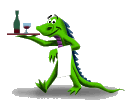 ~"First You Make a Roux"~
(pronounced roo)
~"First You Make a Roux"~
(pronounced roo)
When asked a recipe, the first words out of a Cajun cooks'
mouth
will be... "First you make a Roux"
Roux (pronounced roo) is the basic ingredient of gumbo,
etoufee,
sauce piquante and stew. It contains an equal mixture of
oil and
flour that is browned and used as a thickening base for
many
Cajun dishes. It not only thickens, but also accounts for
the
different and quite distinct flavor of the dish.
All of the recipes on this home page that require a roux
are best
prepared using this formula.
1cup of flour
1 cup of oil
Heat the oil in a heavy, thick pot or skillet. Add flour
and stir
constantly over a low heat until dark brown. The trick is
to get
it dark brown (color of a Hershey's chocolate bar) but not
burned. If it burns, (it will smell scorched) throw it out
and start over.
Warning: The roux will be extremely hot and can cause a
serious
burn. Please be careful when handling it and try not to
get any on you.
~JAMBALAYA~
2 lb chopped white onion
3 lb smoked hot sausage, cut up
2 bunches green onion tops
2 cans blackeyed peas
1 large bell pepper
3 lb uncooked rice
5 cloves garlic chopped
1 cup chopped parsley
3 lb salt meat, boiled, cut up
12 cups water
1 tsp. black pepper
1 tsp. red pepper
Saute onions, pepper, garlic, and parsley. Cook until limp.
Add salt meat, sausage, blackeye peas with liquid and rice. Add
seasoning. Add 12 cups water. Bring to boil; mix well and
cover tightly. Cook on lowest heat for 45 minutes. DO NOT remove
the cover during this time. Remove cover for 10 minutes before
serving. (serves 20)
~SHRIMP CREOLE~
1 cup flour
1 cup oil
3 lb. raw peeled shrimp
1 large can of tomato sauce
2 cloves chopped garlic
2 small cans of tomato paste
2 cup chopped onion
2 bay leaves
2 tbsp. chopped parsley
3 tsp. salt
1 cup chopped celery
1/4 tsp. red pepper
2 tbsp. chopped onion tops
1/2 tsp. black pepper
1/2 cup bell pepper
6 cups of water
Make a roux. Add onions, celery, bell pepper and garlic and
cook until soft. Add tomato sauce, tomato paste, and remaining
spices...Mix well and cook about 5 minutes. Add bay leaves,
6 cups of water and let simmer for about 90 minutes. Add 3
pounds shrimp and cook for 15 minutes. Add parsley and onion tops
and cook for 5 minutes. Serve hot over fluffy rice. Don't eat
the bay leaves!
~SEAFOOD GUMBO~
1 cup flour
1 cup oil
1 large onion
1 pint oysters (3-4 dozen)
2-3 garlic pods
1 lb. peeled shrimp
1/2 bell pepper
1 lb. crab claw meat
1/2 cup parsley
3 tsp. salt
1/2 cup green onions-chop
2 tsb. black pepper
3 quarts water
1 tsp. red pepper
3 bay leaves
1/2 doz. whole cleaned crab
Make a roux with equal parts oil and flour. Cook slowly,
stirring often, until brown. Add cut up onion, garlic, and bell
pepper to the roux. Carefully stir roux until it has cooled down.
Slowly add 3 quarts of water, stirring while you pour. Add salt,
red pepper and black pepper.
Add crab claw meat, and several cleaned whole crabs and
cook an hour. Add shrimp and liquid from pint of oysters, simmer
for 30 minutes. About 15-20 minutes before you serve the gumbo,
add oysters, chopped parsley, bay leaves and green onion tops.
Serve on rice. Have fresh file' on hand to allow guests to add
their own. A side dish of potato salad is always appreciated.
Oh by the way....don't eat the bay leaves.
This freezes well. However, do not freeze the gumbo with
oysters in it. Add fresh ones before serving. Gumbo always seems to taste better after it has set overnight. I usually try to prepare mine the day before to enhance the true flavor of Gumbo.
~Acadian and Cajun Recipes~
Laissez les bons temps rouler!



~CAJUN LINKS~
~Villa
Platte Homepage~~A True Cajun Town &
People~
~Cajun
Cooking~


|